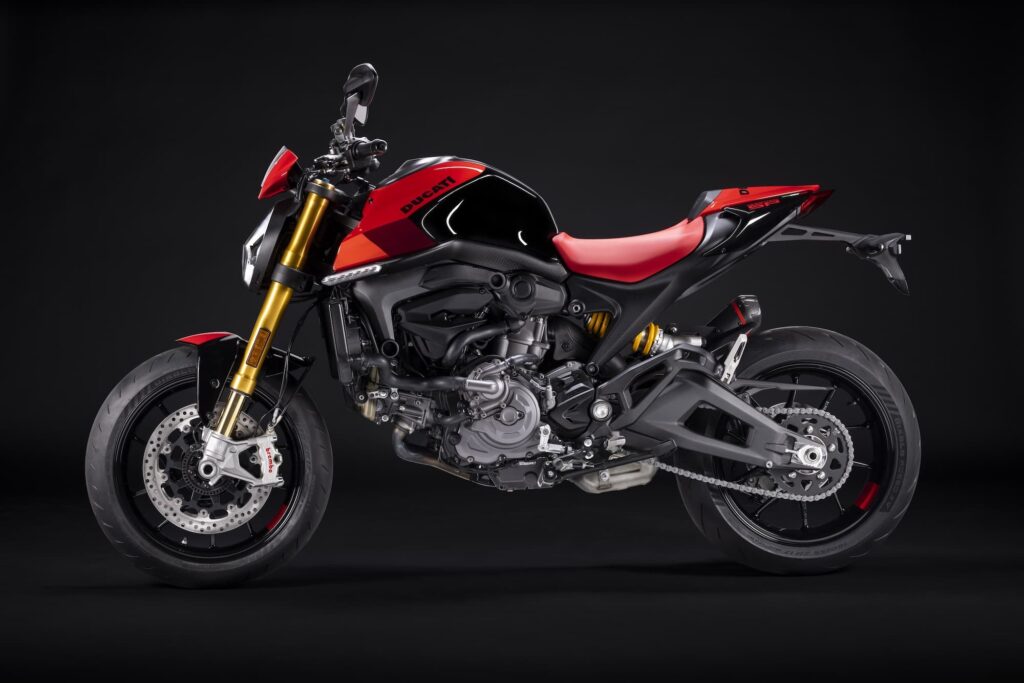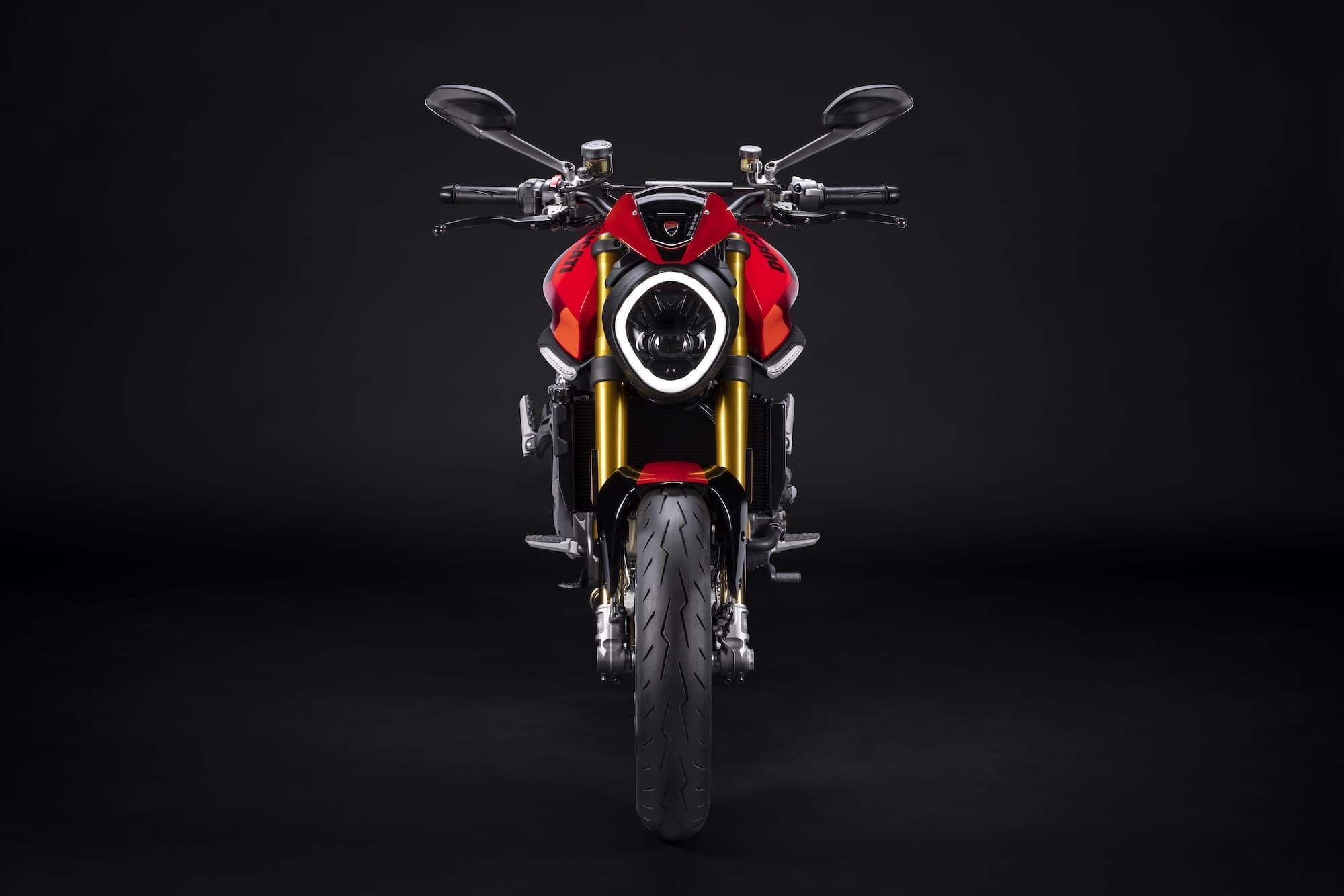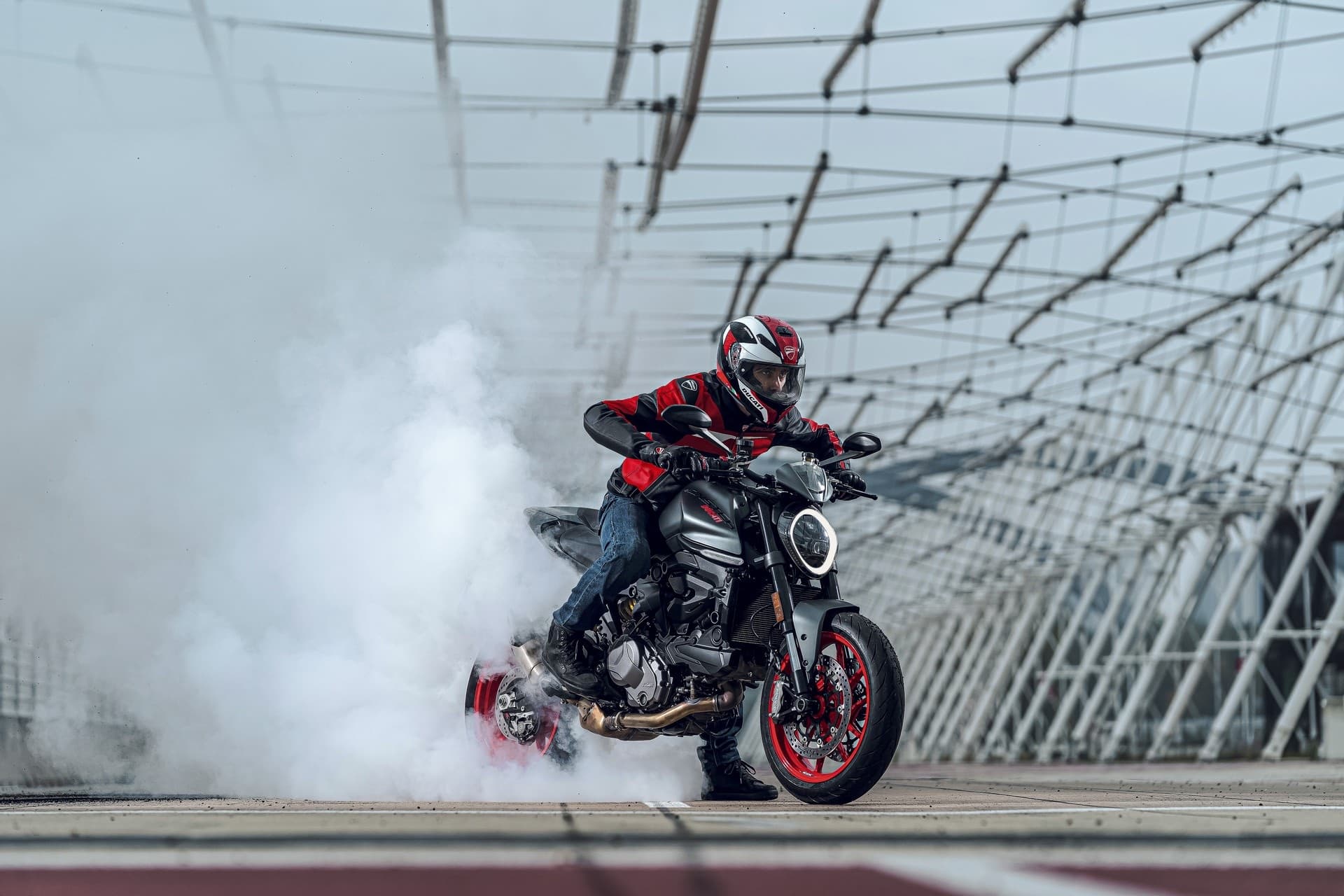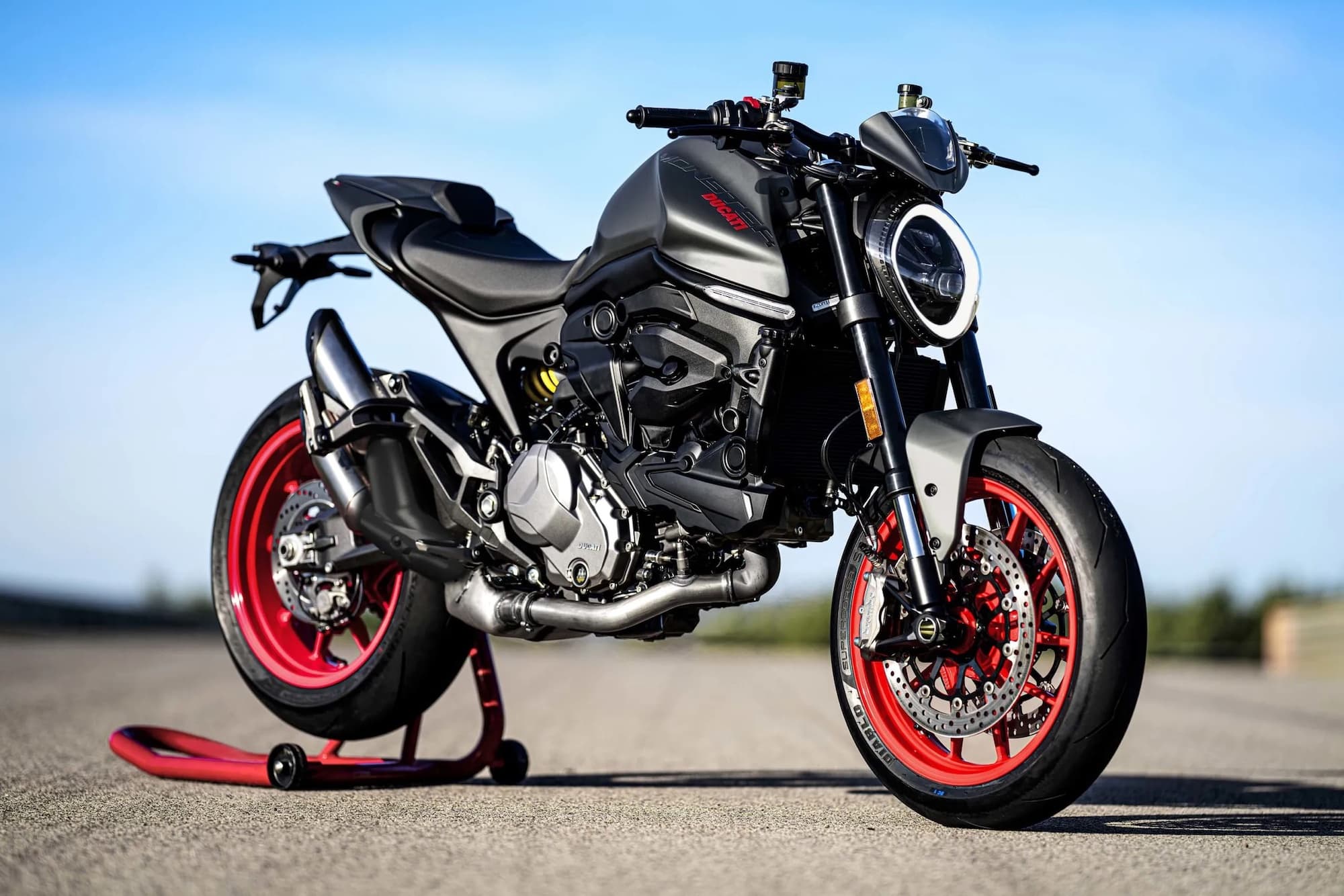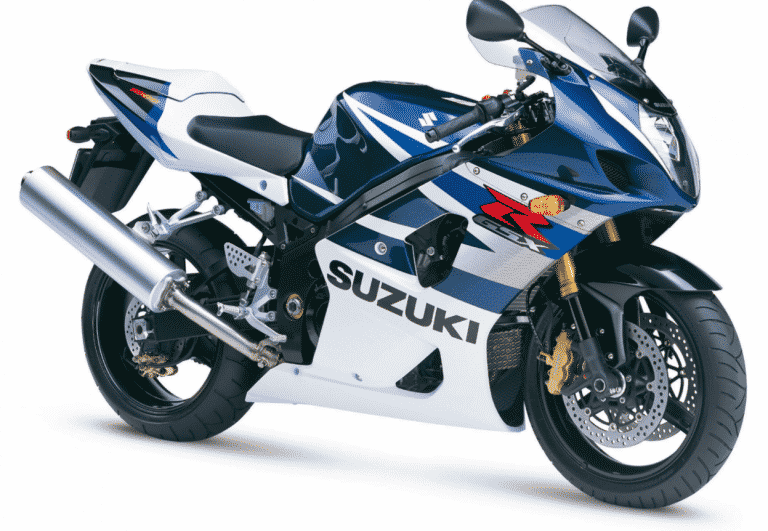Ducati Monster 937 (2021+, 937cc) Maintenance Schedule and Service Info
This is the maintenance schedule for the 2021+ Ducati Monster and Monster+ with the 937cc Testastretta engine, sometimes unofficially called the Ducati Monster 937.
The 2021+ Ducati Monster is called just the Ducati Monster or Monster+, but on the Internet reviewers/writers call it either the Ducati Monster 937, similar to other Ducati models with the same engine as a base.
The 2021+ Ducati Monster replaces the Ducati Monster 821 (which had that explicit name) as well as the air-cooled Ducati Monster 797 (which, looked at another way, you could say was discontinued).
The new Ducati Monster 937 uses the 937cc L-twin “Testastretta 11-degree” engine that’s also seen in the Ducati Hypermotard 950 and a few other Ducati motorcycles. So a lot of the parts and many aspects of the maintenance schedule overlap.
Here are all our Ducati Monster maintenance schedules:
Air/oil-cooled Ducati Monsters
- Ducati Monster 900 (Carb)
- Ducati Monster 900 i.e. (EFI)
- Ducati Monster 800 (WIP)
- Ducati Monster 1000 / S
- Ducati Monster S2R800
- Ducati Monster S2R1000
- Ducati Monster 1100 (including S, Evo)
- Ducati Monster 659 Gen 1
- Ducati Monster 659 Gen 2
- Ducati monster 620 i.e.
- Ducati Monster 695
- Ducati Monster 696
- Ducati Monster 796
Liquid-cooled Ducati Monsters
- Ducati Monster S4
- Ducati Monster S4R
- Ducati Monster S4Rs
- Ducati Monster 821
- Ducati Monster 797
- Ducati Monster 1200 (2014-2016), and Monster 1200 S 2014-2016
- Ducati Monster 1200 (2017+), and Monster 1200 S 2017+
- Ducati Monster 1200 R
- Ducati Monster 937 (including +)
- Ducati Monster SP
In the 2021+ Ducati Monster 937, the engine makes 82 kW (111 hp) at 9250 rpm, with torque peaking at 93 Nm (69 ft-lb) at 6500 rpm.
For the 2023 model year, Ducati released the higher-spec Ducati Monster SP, with higher-spec brakes, suspension, and a few other parts.
This post was originally published on July 6, 2021, but we have significantly updated it since.
This site has links for things like oil and spark plugs from which we earn a commission (which unfortunately nobody can save, not even us). If you appreciate this work, then please use those links. Thanks!
Service Intervals for the Ducati Monster 937
The Ducati Monster 937 has service intervals of 9000 miles / 15000 km or annually. At that distance, change the oil and filter, and go through the list of checks below on the chassis and wearable components. If you ahven’t done that distance in two years, Ducati recommends you change the oil anyway.
The major service interval for the Ducati Monster 937 is 18000 miles or 30000 km, when you do a full Ducati “Desmo” service, including changing the timing belts and checking the valve clearances.
Since the Monster 937 uses a 4-valve-per-cylinder engine with Desmodromic timing, there are 8 clearances to check/adjust per cylinder and 16 total. Also, changing an opener clearance usually means you have to change a closer, per Ducati.
Aside from that, the Ducati Monster 937 needs periodic replacement of the timing belts, even if you don’t do the mileage.
Finally, the Ducati Monster 937 has clutch fluid as well as brake fluid, so change them at the same time.
Maintenance schedule for the 2021+ Ducati Monster and Monster+
This maintenance schedule below for the Ducati Monster 937 is in the same format as in the manual, though altered to fit this screen.
Ducati separates out “customer” items and “dealer” items — they think customers should just change oil, check fluid levels, and grease obvious external things.
Note about harsh/dusty conditions: “Using the motorcycle under extreme conditions, such as very damp and muddy roads or dusty and dry environment, could cause above-average wear of components like the drive system, the brakes or the air filter. If the air filter is dirty, the engine could get damaged. Therefore, this might translate into required service or replacement of the wearable parts earlier than specified in the scheduled maintenance chart.”
Ducati Monster and Monster+ Regular / Pre-ride maintenance
This is maintenance that you can do yourself (though the manual says you need a dealer to do it). You should do these checks regularly — e.g. before every big ride or weekly if you use it as a commuter.
The manual suggests you do these items every 1000 km / 600 miles, or 6 months — whichever comes earlier.
| Ducati Monster 937 regular maintenance |
|---|
| Check the engine oil level |
| Check brake fluid level |
| Check tyre pressure and wear |
| Check the drive chain tension and lubrication |
| Check the brake pads. If necessary, replace, contacting your dealer if necessary. |
Ducati Monster and Monster+ — Full Maintenance Schedule
Follow the following maintenance schedule, observing the distance or time interval — whichever comes earlier.
The major “Desmo service” interval for the 2021+ Ducati Monster is every 30000 km (18000 miles).

Notes:
- We broke this maintenance schedule into the full schedule of major items to check/replace and the annual service checklist for ease of reading.
- Items marked [D] are those that dealers must do unless you have the official gear (“DDS”).
| Km x 1000 | 1 | 15 | 30 | 45 | 60 | |
|---|---|---|---|---|---|---|
| Mi x 1000 | 0.6 | 9 | 18 | 27 | 36 | Every |
| Perform annual service checklist (see below) | ✓ | ✓ | ✓ | ✓ | ✓ | Year |
| Change engine oil and filter | ✓ | ✓ | ✓ | ✓ | ✓ | 2 years |
| Check and clean air filter | ✓ | ✓ | ✓ | ✓ | Year | |
| Change air filter | ✓ | ✓ | – | |||
| Change timing belts | ✓ | ✓ | 5 years | |||
| Check and/or adjust valve clearance | ✓ | ✓ | – | |||
| Change spark plugs | ✓ | ✓ | – | |||
| Change coolant | ✓ | ✓ | 4 years | |||
| Change front fork fluid | ✓ | |||||
| Change brake and clutch fluid | 2 years | |||||
| Check front and rear brake disc and pad wear. Change if necessary. | ✓ | ✓ | ✓ | ✓ | Year | |
| Check rear brake disc screw tightening (by removing the rear wheel shaft in case of brake disk retaining screws requiring the use of hexagon wrench) | ✓ | ✓ | – | |||
| Check the cush drive damper on rear sprocket and lubricate the rear wheel shaft | ✓ | ✓ | – |
Annual service checklist
This is the list of items to check. It’s separated out for ease of reading.
Notes:
- Items marked [D] are those that dealers must do unless you have the official gear (“DDS”).
- Items marked [NBI] aren’t necessary at break-in
| Annual service checklist — Ducati Monster 937 |
|---|
| [D] Read error memory with DDS 3.0 and check technical updates and recall campaigns on DCS |
| Check wear of chain, front and rear sprocket, and final drive chain elongation, tension, and lubrication. Record detected elongation value |
| Visually check the front fork and rear shock absorber seals |
| Check brake and clutch fluid level |
| [NBI] Check the proper tightening of the front and rear brake calliper bolts and the front brake disc bolts |
| [NBI] Check front and rear wheel nuts and rear sprocket nut tightening |
| [NBI] Check the tightening of frame fasteners to engine, swinging arm, and rear shock absorber |
| [NBI] Check wheel hub bearings |
| [NBI] Check the play of steering tube bearings |
| Check the freedom of movement and tightening of the side stand |
| Check that all gaiters and flexible hoses in view (e.g. fuel, brake and clutch hoses, cooling system, bleeding, drainage, etc.) are not cracked, are properly sealing and positioned |
| Check free play of rear brake lever and lubricate the levers at the handlebar and pedal controls |
| Check the free play of the cable clutch lever (where present) |
| Check tyre pressure and wear |
| Check the operation of all electric safety devices (clutch and side stand sensor, front and rear brake switches, engine kill switch, gear/neutral sensor) |
| Check lighting devices, turn indicators, horn and controls operation |
| Final test and road test of the motorcycle, testing safety devices (e.g. ABS, DTC, and VHC), electric fans and idling |
| Visually check the coolant level and sealing of the circuit |
| Softly clean the motorcycle |
| Service coupon registration with turning off of Service warning light on instrument panel with DDS 3.0 and filling in of the on-board documentation (Service Booklet) |
Measuring chain tension / elongation on the Monster SP
It’s important to regularly check the chain tension and wear level. See the below notes.
To check the tension, push down on the chain and release it. Then measure from the centre of a link pin to the end of the sliding shoe on the swingarm. The distance should be 53-55 mm under static no-load conditions.
If it’s not, the manual recommends you get a Ducati service centre to service your bike.

Tightening Torque specs
Below are torque specs that are publicly available. These come from the service manual.
| Item | Nm | lb-ft |
|---|---|---|
| Engine drain bolt (with magnet) | 20 | 15 |
| Oil mesh filter plug | 42 | 31 |
| Spark plugs | 12 | 9 |
| Oil filter (cartridge) Use engine oil on seal | 12 | 9 |
| Brake disc fastener | 30 | 22 |
| Front brake caliper fastener (both sides) | 45 | 33 |
| Front wheel nut | 63 | 46 |
| Rear brake caliper to holder screw | 25 | 18 |
| Rear brake disc fasteners | 25 | 18 |
| Rear axle nut (right side nut; Loctite on left) | 145 | 107 |
| Handlebar lower U-bolt to steering head fasteners | 45 | 33 |
| Steering head on fork fasteners | 24 | 18 |
| Front sprocket fastener | 186 | 137 |
| Rear sprocket fasteners | 46 | 34 |
These are from the Ducati Monster workshop/service manual, which someone kindly uploaded to Google Drive. (See this thread on ducatimonster.org).
Here are just the torque specs so you can search for more.
Tyres sizes and pressures for the 2021+ Ducati Monster 937
The manual for the Ducati Monster 937 and Monster+ specifies the following tyre sizes and pressures.
| Wheel | Tyre size | Tyre pressure (cold) |
|---|---|---|
| Front | 120/70 ZR17 M/C 58W | 2.3 bar / 33 psi (rider only) 2.5 bar / 36 psi (with passenger) |
| Rear | 180/55 ZR17 M/C 73W | 2.5 ba r/ 36 psi (rider only) 2.9 bar / 42 psi (with passenger |
Stock, the 2021 Ducati Monster 937 ships with Pirelli Diablo Rosso III tubeless tyres.
About the 2021+ Ducati Monster and Monster+
The 2021 Ducati Monster 937 is a significant departure from the Ducati Monster models that preceded it, and a huge departure from classic Monsters. Although all the changes have been gradual and snuck up on Ducatisti over the decades.
The 2021+ Ducati Monster is just called that — the “Monster”. But it’s easier to refer to it as the 937, after the displacement of the engine, to differentiate it from predecessors.
The Ducati Monster 937 replaces the Monster 821, but is significantly different. The base engine is the same conceptually — a Testastretta-11 eight-valve L-twin with liquid cooling and belt-driven desmodromic valves.
But Ducati changed a lot, eschewing the trellis frame of the 821 (and all preceding Monsters), replacing it with the “front frame” — and shedding many kilos of weight in the process.
It’s interesting to see just how far the Monster has come by comparing it not just to its predecessor, but to the original Monster 900. The displacement is quite similar to the original Monster. But most other things have changed.
| Model | 1993 Monster 900 | 2021 Monster 937 |
|---|---|---|
| Frame | Chrome-molybdenum steel trellis | Aluminium alloy “Front frame” |
| Engine | Air/oil-cooled Desmodue, belt-driven cams | Liquid-cooled Testastretta 11-degree, belt-driven cams |
| Displacement | 904 cc | 937 cc |
| Valves | 2 per cylinder, Desmodromic actuation | 4 per cylinder, Desmodromic actuation |
| Peak power | 59 kW / 80 hp @ 7000 rpm | 82 kW /111 hp @ 9250 rpm |
| Clutch | Dry | Wet |
| Ride aids | None | Cornering ABS / TC, ride modes, etc. |
| Service intervals | 6000 mile / 10000 km oil change and valve clearance check, belt replacement every 2 years | 9000 mile / 15000 km oil change, 18000 mile / 30000 km valve clearance check, belt replacement every 5 years |
While the first Monster was called a “parts bin special”, the new Monster is not that at all. It’s its own beast, designed from the ground up… though with a motor that’s still borrowed from other motorcycles in the line-up (e.g. the Ducati Supersport 950).

The new Monster also takes the place of the Ducati Monster 797 (in markets where it was sold, e.g. the US), but not in any sense other than the commercial fact that the 797 (a fairly simple, still air/oil-cooled Monster) has been discontinued.
The modern Monster though didn’t just lose the frame — it loses quite a bit of weight. The 937cc engine is 2.4kg lighter than the 821cc version, and the frame is 4.5kg lighter. The subframe is lighter, and so are the wheels, so the total wet weight of the 2021 Monster drops from 206 kg wet for the Monster 821 to 188 kg wet for the 2021 Ducati Monster — a shocking drop.

Ducati released the “front frame” concept first on the Ducati Panigale V4 superbike. It’s similar to a monocoque (single-piece) frame in that it is built mostly in one piece, and designed to optimise rigidity and weight. Like on the Panigale V4, the frame is made of aluminium.
The impact on weight savings is significant — the frame is 4.5 kg or 10 lb lighter than the trellis frame on the 821 model. The new Monster competes quite well with other class-leading sport nakeds like the 2021 Yamaha MT-09 and Triumph Street Triple RS, and picking the one you want is likely to be an exercise of brand loyalty, a compelling salesperson, or how you’re feeling on a certain day.
The “Plus” model of the Ducati Monster, released with the first Monster, is purely cosmetic.
For 2023, Ducati released the up-spec Ducati Monster SP, with a number of updated parts, including Öhlins suspension, Brembo Stylema calipers, and Pirelli Diablo Rosso IV tires.
And for 2024, Ducati released the limited edition Anniversario in celebration of the 30th anniversary, which comes with Italian flag-based colours (red, green, and white), plus with some extra tasty bits. The headline improvement is the forged wheels, which reduce weight by another 2 kg / 4 lb — and where it counts most, in un-sprung mass.

Below is a table summarising the model variants of the Ducati Monster models (2021+).
| Part | 2021 Monster / Monster+ | 2023 Monster SP | 2024 Monster 30th Anniversario |
|---|---|---|---|
| Front suspension | 43mm USD fork, non-adjustable | 43mm USD Öhlins fork, TiN treatment, fully adjustable | 43mm USD Öhlins fork, TiN treatment, fully adjustable |
| Rear suspension | Monoshock, preload adjustable | Öhlins monoshock, fully adjustable | Öhlins monoshock, fully adjustable |
| Wheels | Light alloy cast | Light alloy cast | Forged (1.86 kg / 4.1 lb lighter) |
| Steering damper | No | Yes | Yes – Öhlins |
| Brake calipers | Brembo M4.32 | Brembo Stylema | Brembo Stylema |
| Tires | Pirelli Diablo Rosso III | Pirelli Diablo Rosso IV | Pirelli Diablo Rosso IV |
| Muffler | Standard | Termignoni | Termignoni |
| Battery | Standard / Maintenance free | Lithium-ion (1.7 kg / 3.8 lb lighter) | Lithium-ion (1.7 kg / 3.8 lb lighter) |
| Curb weight | 188 kg / 414 lb | 186 kg / 410 lb | 184 kg / 406 lb |
Ducati Monster and Monster+ Owner’s Manual
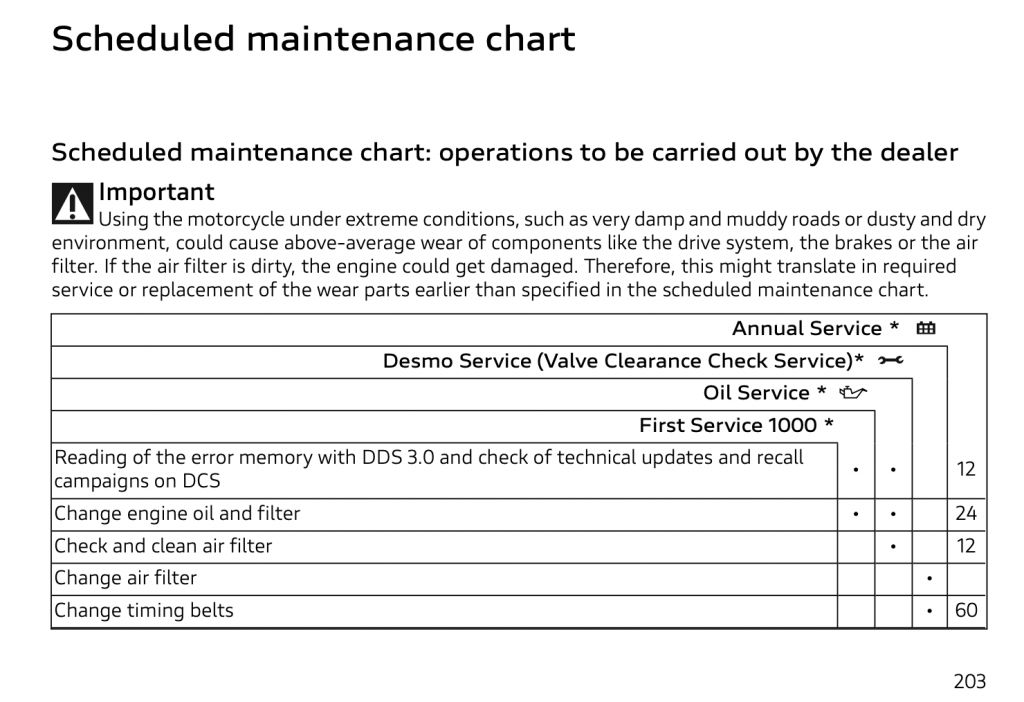
The manual says regarding the intervals:
- The “First Service 1000” must be carried out after the first 1,000 km/600 mi
- The Oil Service (oil pourer) must be carried out every 15,000 km/9,000 mi.
- The Desmo Service (wrench) must be carried out every 30,000 km/18,000 mi.
- The Annual Service (calendar) must be carried out every 12 months.
The above info was sourced from the owner’s manual, which is available below for download in PDF format for archival purposes.
You can download a copy from the Ducati website here.

